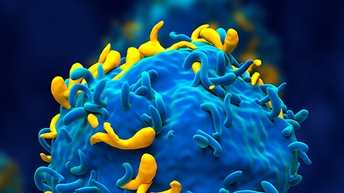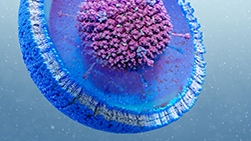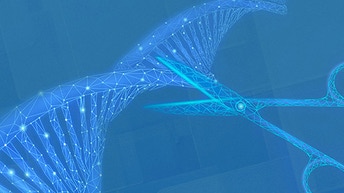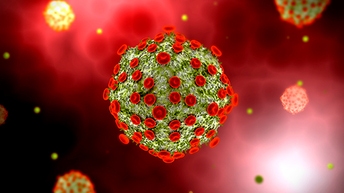Democratizing base editing with the Pin-point platform
To provide broad access to base editing across the research and therapeutic market, we offer Pin-point base editing reagents and services, as well as licensing to the underlying patents and patent applications.
Explore Pin-point reagents | Discover Pin-point services
Explore the Pin-point base editing platform
Key Features
A strategic asset for therapeutic developers

IP-Independent innovation
- Only base editing technology that uses RNA aptamers for deaminase recruitment
- Independent of other base editing systems, helping secure your path to commercialization
- Foundational technology established by Rutgers University and further developed by Revvity
- AI-enhanced adenine deaminase editing available through our collaboration with Profluent (read press release)
- Only base editing technology that uses RNA aptamers for deaminase recruitment
- Independent of other base editing systems, helping secure your path to commercialization
- Foundational technology established by Rutgers University and further developed by Revvity
- AI-enhanced adenine deaminase editing available through our collaboration with Profluent (read press release)
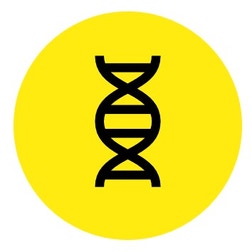
Engineered for clinical complexity
- Achieves precise, scarless edits while avoiding risks associated with double-strand DNA breaks
- Supports independent or simultaneous CBE and ABE editing
- Enables multiplex base editing with knock-in and knockout in a single step, ideal for T cell and iPSC-derived therapies
- Verified with AI-generated enzymes
- Achieves precise, scarless edits while avoiding risks associated with double-strand DNA breaks
- Supports independent or simultaneous CBE and ABE editing
- Enables multiplex base editing with knock-in and knockout in a single step, ideal for T cell and iPSC-derived therapies
- Verified with AI-generated enzymes

Verified, scalable, and ready-to-go
- Demonstrated clinical-grade performance in T cells, iPSCs, and HSPCs
- Low cytotoxicity and reduced off-target activity compared to other CRISPR methods
- An mRNA and synthetic sgRNA based system with a clear path to GMP
- Demonstrated clinical-grade performance in T cells, iPSCs, and HSPCs
- Low cytotoxicity and reduced off-target activity compared to other CRISPR methods
- An mRNA and synthetic sgRNA based system with a clear path to GMP

Backed by peer-reviewed science
- Molecular therapy (2024) - https://www.cell.com/molecular-therapy-family/molecular-therapy/fulltext/S1525-0016(24)00423-4
- Nature biotechnology (2025) - https://www.nature.com/articles/s41587-024-02240-0
- CRISPR journal (2020) - https://www.liebertpub.com/doi/10.1089/crispr.2020.0035
- bioRxiv (2025) - https://www.biorxiv.org/content/10.1101/2025.06.05.656583v1.full
- Molecular therapy (2024) - https://www.cell.com/molecular-therapy-family/molecular-therapy/fulltext/S1525-0016(24)00423-4
- Nature biotechnology (2025) - https://www.nature.com/articles/s41587-024-02240-0
- CRISPR journal (2020) - https://www.liebertpub.com/doi/10.1089/crispr.2020.0035
- bioRxiv (2025) - https://www.biorxiv.org/content/10.1101/2025.06.05.656583v1.full
AI-engineered adenine deaminases
Precision, redefined.
With Profluent's AI-engineered adenine deaminases and the Pin-point platform, data shows enhanced target specificity - achieving cleaner edits than laboratory evolved enzymes reported in the literature. Read on to explore the power of DBS-free base editing.

High-efficiency editing
Consistently high efficiency across multiple loci - without compromising precision. Our data shows 90 % A→G conversion across diverse genomic targets.

Cleaner edits
Enhanced target specificity than laboratory evolved enzymes. In many targets, we see markedly fewer bystander edits and high on-target efficiency.

Control at the smallest scale
When it comes to precision less may mean more. Our data shows we can titrate ≥100× and maintain high on-target efficiency and lower bystander edits.

Safety you can trust
Cleaner edits aren't just efficient, they're predictably safe. Our data shows low to undetectable increases in mutation rate with near-baseline levels of spurious deamination.
Pin-point base editing platform capabilities at a glance
| RNA-based modularity | Interchangeable components for precise, configurable editing windows |
|---|---|
| Simultaneous KO + HDR KI | Multiplexed engineering without multiple nuclease species |
| Optimized for DSB-sensitive cells | Reduced DNA damage and improved cell viability in iPSCs, HSPCs and T cells |
| Flexible Cas & deaminase compatibility | Integrates with Type II/V nucleases and novel deaminases |
| Customizable workflows | Use Revvity reagents or partner with our expert scientists for custom service options. |
How does the Pin-point base editing platform work?
Base editing can create precise single base A to G or C to T changes in the genome through the use of an adenine or cytidine deaminase, respectively. These single base changes have the potential to correct disease causing mutations or can be used to introduce splice site disruptions or premature stop codons that can generate functional protein knockouts.
The Pin-point platform is unique because it uses an RNA aptamer on the gRNA as a "handle" to recruit the deaminase to the Cas/gRNA complex, which contains an aptamer binding sequence. Revvity’s aptamer-driven approach allows for highly complex editing, such as recruitment of an adenine deaminase to one locus and a cytidine deaminase to another locus. It also enables multiplexed knockout and knock-in (Porreca et al. Molecular Therapy 2024).

In one possible configuration of the Pin-point platform, a catalytically modified nickase Cas9 (nCas9) is directed to the target site by a single guide RNA (sgRNA) that includes an extended RNA aptamer scaffold. The RNA aptamer recruits the deaminase (here shown as a cytidine deaminase) via the aptamer binding protein domain.
Featured resources
FAQs
-
How customizable is the Pin-point base editing platform for specific targets?
Every target is different. That’s why the Pin-point system was designed with flexibility at its heart. Unlike traditional base editors that rely on fixed, Cas-fused constructs, the Pin-point platform uses a modular aptamer-recruitment system, decoupling the Cas targeting machinery from the deaminase payload. This architecture allows for precise customization of editing conditions based on your target site, cell type, and delivery method.
What can be tuned?
- Choice of deaminase – A growing toolbox of deaminases allows for different editing windows and sequence preferences.
- Recruitment strategy – Aptamer-based recruitment offers the ability to recruit different deaminases to different locations of the genome in a single reaction.
- Titration of editing components – Delivery of each component (Cas, deaminase, gRNA) can be balanced to favor efficient on-target editing with reduced off-target risk.
- Cell-type-specific optimization – Expression levels, editing kinetics, and repair environments vary across cell types. The Pin-point system can be fine-tuned accordingly.
-
What if I have a tough or sensitive target?
Whether you’re working with difficult PAM contexts, narrow editing windows, or targets prone to off-target liabilities, we’re here to help. Our team collaborates with partners to identify the right configuration and support testing in relevant systems, either through technical evaluation or co-development.
We meet you where you are. The Pin-point platform isn’t a one-size-fits-all solution, it’s a flexible toolkit to help you solve your specific gene editing challenge, with the data, support, and licensing model to back it up.
-
Can I multiplex edits using the Pin-point base editing platform?
Yes, and you should. In many current editing workflows, especially for iPSC-derived or T cell therapies, each edit is done sequentially:
- One edit per transfection
- Multiple rounds of culture and selection
- Compounding stress, culture-acquired abnormalities, and genomic instability
With the Pin-point base editing platform, you can make multiple edits in a single round, without double-strand breaks (DSBs) and without overloading the cell.
Here’s how:
- Cas-deaminase decoupling allows a single Cas to perform multiple functions independently and specifically
- Aptamer-recruitment enables multiple deaminases to be directed simultaneously to different loci
- Reduced exposure time and titratable elements minimize off-target activity, even with multiplexed editing
Get in touch with our team to discuss how multiplex editing could be applied in your system.
-
What are the applications of multiplex editing?
As gene and cell therapy programs grow more sophisticated, the need to modify multiple targets simultaneously has become central to improving efficacy, safety, and manufacturability. Multiplex base editing enables complex engineering strategies that would be impractical or risky with traditional nuclease methods:
- Multiple knockouts to deactivate redundant or suppressive genes
- Knockout + knock-in to inactivate a locus and reprogram it with a functional sequence or exogenous payload
- Polygenic SNV correction for multigenic diseases or immune evasion profiles
- SNV correction + knock-in to restore function and deliver a payload simultaneously
- Dual ABE and CBE editing for precision tuning across adenine and cytosine targets in one go
Why does this matter? It means less time in culture, a lower risk of unwanted mutations, and a more development-friendly path to clinical-grade cells.
If you want to see how multiplex editing could be applied in your system, let’s talk - get in touch with our team today.
-
What makes base editing safer than traditional CRISPR-Cas9 approaches?
One word: precision. For therapeutic applications, DNA safety is non-negotiable. Traditional CRISPR-Cas9 and nuclease-based approaches work by inducing double-strand breaks (DSBs) in the genome. While effective for gene knockout, this strategy comes with known risks:
- Genotoxic stress from repeated or persistent DNA damage
- Structural variants and large deletions at or near the cut site
- Chromosomal rearrangements, especially in stem cells or long-term engrafting cells
Regulators are paying attention. Recent FDA guidance for cell-based gene therapy calls for deeper characterization of editing-related genomic changes and minimizing unintended modifications wherever possible.
With the Pin-point base editing platform, we avoid DSBs from the start. Instead of breaking the DNA, we make single-nucleotide changes at the base level with high efficiency and low disruption.
This matters because cleaner genomes lower the risk for oncogenic transformation. Shorter culture time for complex engineering means fewer opportunities for culture-acquired mutations, and reduced DSBs also reduced stress on sensitive or long-lived cell types
Furthermore, almost any CRISPR knockout used in a therapeutic setting can be achieved via base editing. From premature stop codons to splice site disruption, we can knock out genes without collateral damage.
If you're still relying on nucleases for clinical editing, it may be time to re-evaluate your risk profile. Contact our team to find out how we can help.
-
Is base editing a replacement for all gene editing applications?
Not every application is a perfect fit for base editing, but you might be surprised by how much base editors like the Pin-point platform can do!
Some applications like large structural rearrangements may still require nuclease-based tools or other strategies, at this point in technology development. But for the vast majority of therapeutic editing applications, base editing with the Pin-point platform offers a safer, smarter path forward.
From simple gene knockouts to complex, multiplexed edits (including knockout and knock-in at the same time), base editing has evolved into a next-generation alternative to traditional CRISPR-Cas9 with real-world advantages:
- Single-gene knockouts via premature stop codons or splice disruption
- Knockout and knock-in workflows using targeted base changes plus HDR for non-viral targeted insertion
- Single or polygenic SNV correction for precision repair of disease-causing mutations
- Multiplex editing with lower risk of genotoxic stress or culture-acquired abnormalities
- And all while avoiding double-strand breaks
What sets the Pin-point platform apart is not just the chemistry, it’s the control, tunability, and enzyme flexibility that makes these applications safer and more feasible across sensitive cell types like T cells, iPSCs, and HSPCs.
In a field where DNA damage is no longer considered benign, DSB-free base editing isn't just a technical upgrade. It's an evolving regulatory and therapeutic imperative.
-
How can I get started with the Pin-point base editing platform?
Whether you're early in evaluation or preparing for program integration, there are multiple ways to begin working with the Pin-point platform:
- Technical evaluations – Conducted under MTA with support from our scientific team to assess performance in your specific cell type, target, or workflow
- Pilot studies – May be performed by your team or contracted to Revvity’s base editing experts, depending on your in-house capabilities
- Licensing – Flexible agreements tailored to your field of use and stage of development
We also offer off-the-shelf RUO reagents with select configurations of the Pin-point platform available as mRNA reagents for researchers looking to quickly test or prototype in-house.
And for turnkey support, Revvity’s preclinical services team provides a range of expert offerings using the Pin-point platform, including:
Whether you're biotech, pharma, or an academic group tackling rare disease, we’re here to help you get started, thoughtfully and efficiently.
Contact our team to discuss your needs today!
You may also be interested in
Partner with us
Whether you’re pursuing platform diversification, clinical innovation, or IP de-risking, the Pin-point base editing platform offers a robust foundation for next-generation therapies.
Get in touch to learn more about:
- Licensing and co-development
- Technical data and protocols
- Reagent kits and custom services
Pin-point™ base editing reagents are available for research use only and are not for diagnostic use or direct administration into humans or animals. The Pin-point™ base editing platform technology is available for clinical or diagnostic study and commercialization under a commercial license from Revvity.

How can we help you?
We are here to answer your questions.































